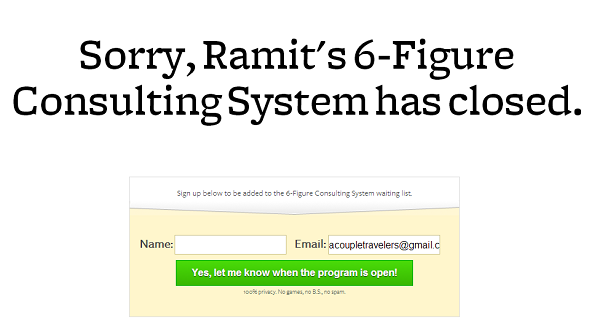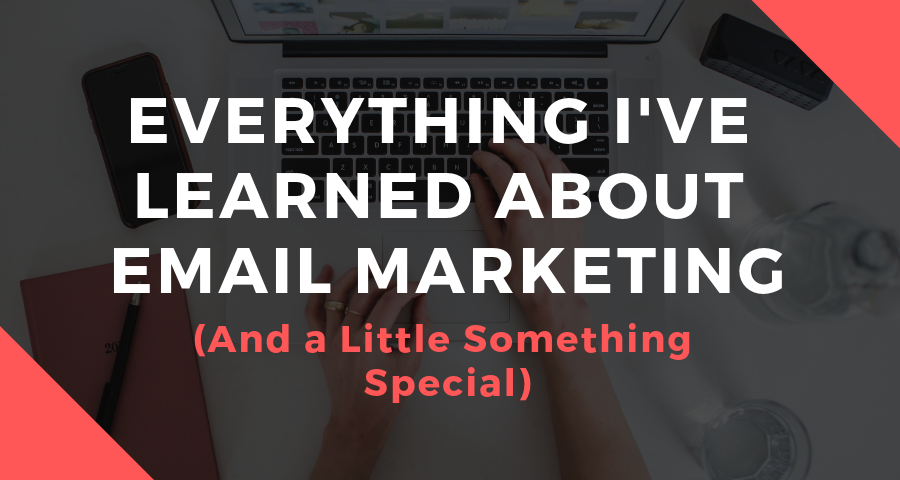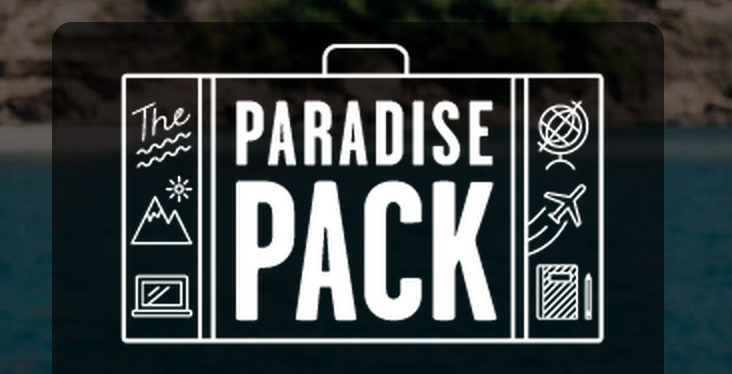This is a guest post from Dave of SelfMadeBusinessman.com.
One of my favorite experiments from last year was running a course online. With very little marketing I was able to get 17 sign ups at $200 each and it cost me virtually nothing to get off the ground. While this pales in comparison to what many of the top dogs are pulling in with their online courses, we did it with an audience of less than 20k page views a month and a good story.
It goes to show just how powerful online courses can be and how low the barrier to entry is.
Today we are going to take an in depth look at online courses. In this guide you will learn:
- Why You Should Run An Online Course
- How To Brainstorm Ideas For A Course
- Strategy For An Effective Online Course
- Advanced Marketing Techniques Used By The Pros
Why You Should Run An Online Course
According to a recent post by Ramit he has labeled online courses as the best online business to start.
And you know he’s done just about everything.
But why is that? Well, consider the following…
- Passive Income – Although you do have to be careful with how you use this term (it gets thrown around quite a lot, and by no means should it be confused with “no work”) a course can be a great source of passive income. After the upfront work of putting it together a course can be highly automated to deliver lessons automatically to the participants. Many people do not take an active presence in their course, as opposed to coaching for instance, which requires you to be front and center.
- Scalability – Forget the classroom mentality. Courses run by the pros literally have thousands of students. Information products are easy to scale and the variable costs are low, so the more people that take it, the better value you are getting for your time.
- Networking – Depending on the size of your course and how involved you are, it can be a great way to network with like-minded and motivated people. Don’t confuse the fact that people are signing up for your course by assuming that they have nothing to offer you. Someone might be a beginner in one area but excel in another that you have no idea about. Courses can also be a great source of testimonials down the line. Look at how Sean has leveraged success stories in his own course.
- Upsell Potential – If someone signs up for your course you’ve really got their attention, and it can be a great way to upsell more products via the course modules. For example, along with the course you can market books, or other features/versions.
- High Priced – A course can certainly be a lot of work, but they also don’t sell for cheap. Many people sell courses for hundreds, even thousands of dollars. You can argue that there might be a lot of value contained in an ebook, for example, but just by the nature of it being an ebook no one is going to pay a thousand dollars. On the contrary, I have seen courses offered for $12k.
- Low Cost – In many cases the startup costs for a course can be quite low, at least relative to a software business or a physical product. Online courses are a form of information product; you simply have to put the material together and market it.
- Longevity – Depending on your topic, you an offer a course year after year. Things like social media management, being a better blogger, negotiating your salary, etc never go out of style, they just have to be updated a bit.
How To Brainstorm Ideas For A Course
The best ideas for courses come from subjects that you are an authority on.
Is there something you’ve been asked more than once?
If so, you should start to take notice. If two people are asking you the same question, you might have the beginnings to a common problem, and this can be a great idea for a course.
Now, you might find that the questions you get are not quite meaty enough for an entire course, so consider taking a step back and looking at the bigger picture. For example, here are some questions and the respective courses they can lead to:
Question: How do you have so many Facebook likes?
Course Equivalent: How to leverage social media for your blog/business.
Question: How do you find advertisers for your blog?
Course Equivalent: How to make money on your blog.
Think about what you do well and what other people might be interested in learning about, and remember to look at the bigger picture of what someone is asking.
The biggest misconception is to think you need to be an expert.
This very article proves contrary to that, as I am not an expert at running courses, but was able to successfully run one last year.
Still need help? Check out this post:
Join over 40,000 people who have taken our 6 part freelance writing course. Sign up below and let’s do this together.
By entering your email address you agree to receive emails from Location Rebel. We'll respect your privacy and you can unsubscribe at any time.
Strategy For An Effective Online Course
Course Materials – How Should The Course Material Be Structured
A course needs material. Ask yourself the following questions:
- What information is absolutely necessary for a participant to fully realize the value of the course?
- How should the information be packaged (chapters, lessons)?
- What is the most effective way to convey the information (video, audio, writing)?
- How much of the course should be available at once (one chapter, several, the whole course)?
- How long should the course last?
There is no right or wrong answer to these questions. You are going to need to tailor the course in the way that you feel is most effective.
If there are similar courses available, do some investigative research and see if you can find out what their syllabus and structure is (many people write this on the sales page).
Pricing – What Should You Charge For Your Course?
With any product or service you offer, you should have a number in mind.
What would it take in earnings for me to consider this a successful launch?
Naturally, your price is a function of that.
There are three ways to price a course.
- Cost – The first is to price it based on what it will cost you. Consider what it will cost to put together and how long it will take you to do so. Give an estimate as to how many people you expect to sign up. Of course it will just be an estimate, but it is probably easy to say whether or not you expect 20 people or 200 people. If you have 20 people you think will sign up and you want to charge $100 each, you can expect to make about $2k. Will that cover the cost of your material and time?
- Value – Another is to price it on the value that it is providing. If you are running a course that teaches people how to negotiate for a higher salary, then that course is potentially worth thousands. Generally, you can charge more for courses directly related to earning more money. A course about effectively using social media, while also beneficial, might not translate to thousands of dollars for the average person.
- Competition – You should also look to see what competing courses are out there and what people are charging for them. If you want to charge $500 for a course that someone else is marketing for only $200, you better be able to convince people how you are providing that additional value to justify the $500 price tag.
Additionally, there are two other factors that come into play albeit not as directly as the others.
- Willingness To Pay – What are people willing to pay for this course? This is a function of your target audience and if they have the money to put into the course you are offering. For example, Ramit’s course Earn1k is about starting a side business to earn a thousand dollars a month. For the course, he charges around $1k. The potential value, one could argue, is $1k a month for years.
- Authority – How credible are you? Are you an authority on the subject. The more authority you have, the more you can justify a higher price tag.
Inevitably when you are pricing a course you are going to want to take into consideration all of these at once. They are not mutually exclusive. At a minimum you are going to want your costs covered. Then, consider the potential value and what competitors are doing.
Marketing – Finding Your Target Audience
There are many ways to market an online course and they depend heavily on your situation. Chances are if you are thinking about making an online course you already have some marketing strategies in mind.
As with any product, you are going to have to find your target audience.
Who are the people that would benefit from this course? Be specific.
Consider two things.
The first, who’s “ear” do you have?
Secondly, where do your customers congregate?
Here are some examples:
Your Blog – If you have a blog then presumably you have an audience/dedicated following. If the course is relevant to your readers you are going to want to market it to them via posts, your newsletter, and social media.
Forums – There are many forums on the internet dedicated to various niches. Find the forums that are relevant to your niche and become a contributor in them. Establish credibility by positioning yourself to be a subject matter expert in your particular field. Half of running a course is all about credibility.
Other Peoples’ Blogs/Newsletter – If you do not have a blog but know someone who does, or can convince someone else to market your course as an affiliate, you can leverage their following.
Paid Advertising – Facebook ads are not to provide great ROI and have excellent metrics for targeting.
Remember with all of the above the strategy for launching your course. If you follow the big guys, they don’t just up and “launch” a course.
It’s a process.
They may start with an announcement, but they don’t take sign ups for weeks or even a month. They spend the rest of their time building up their authority and reminding you why they are an expert on the subject.
Recently Ramit announced that he is starting a course on how to start an online business. But he didn’t just launch it right away. He is constantly coming out with new, informative teaser posts about how to start an online business to rally people around the launch. Consider the posts on his blog that followed that announcement:
- Business Ideas: Which Online Business Should You Start
- Online Business: From My First Sale To A $12,000 Product
See the trend here?
Sales – How To Package Your Course To Get Sign Ups
Once you have done all of the above you are going to need market your course. A great sales page at a minimum will answer the following:
- Who am I and why am I a credible source for this information?
- What is being offered?
- An outline of the topics covered
- Testimonials from people you have helped in the past, or better yet, former course participants.
- How much does it cost?
Bonus Tip: Start with a story
People relate well to stories. They want to imagine themselves in the course and being successful. You have to create the very image of this for them. If you do, they can’t help but sign up.
Here are some great landing pages
- Location Rebel Academy
- Nomadic Matt’s Blogger Mentorship Program
- Green Global Travel How To Be A Better Blogger
- Point Blank SEO Link Building Training Course
Take a look at them and see if you can check the boxes.
Location Rebel Landing Page Case Study
- Starts with a compelling anecdote about missing opportunities.
- Builds up Sean as an authority. How he transformed his life, and how he can do the same for you.
- What is being offered – Location Rebel is the only course of its type designed to teach you all of the skills necessary to run a lifestyle business from anywhere on Earth.
- What you’ll get – content, interviews, forum; step by step instructions on how Sean changed his life
- Testimonials of Location Rebel success stories
- Pricing – actually this appears on a separate, check out page.
Here are some nice resources for creating landing pages:
- Landerapp – This is free and has some nice features such as a/b testing. You can create several different landing pages and see which ones performs better for opt ins.
- LeadPages – Costs $37/month, but is considered one of the best services for landing page creation.
- OptimizePress – Similar to LeadPages but a one time fee.
How To Deliver Your Course
There are many ways to deliver a course to your students. The best way is to have it automated some how so you don’t have to manage every student, especially if it is ongoing.
- Separate Newsletter – This is a very easy way to go about it. Create a separate newsletter list and then you can use a follow up series (as it is called in Aweber) to deliver content on your set schedule.
- Separate Members Only Website – Depending on how professional you want to be, you can create a separate website that requires a login and password so only members can access it. From here students can get to the lessons, forums, support, etc.
- Online Course Websites – There are specific online course websites like Udemy which allow you to build your own course online.
Advanced Marketing – Strategies To Increase Sales
Minimum Sign Ups – If this is your first time marketing a course and you are not sure how many people will sign up, you might want to consider marketing it BEFORE you’ve put in the time investment to actually build it out. The idea is that you want to Gauge interest before committing fully. Your sales pitch is not the course itself but it is the outline of the course. You can easily create a landing page and then start marketing it and collect pre sign ups.
The Money Back Guarantee – We all know this and love it. In Ramit’s Earn1k course he offers a full money back guarantee usually for 4-8 weeks of the course. The fact of the matter is that most people are honest and they will not take advantage of your kindness if you are providing value. Sure, there will always be some people who will take the course and then ask for their money back just because they can, but the question is does it outweigh the number of incremental sign ups you will get by offering it? In most cases it will not.
Restricted Open Period – If you are offering a course in high demand, you can implement a set number of days (say 72 hours) to be a window when people can sign up. This creates a sense of urgency and inspires people to act. It also helps weed out unsure, uncommitted people. Quite often I have seen landing pages that utilize a countdown clock for added effect.
Offer A Few For Free (Or Discount) – Consider inviting a few people to take your course for free, or at a discounted price. In exchange for this you can get edits/criticisms for your course. There is no substitute for hearing critique from the other side, as well as testimonials. Again, don’t be hesitant to give a few things away, you’ll potentially get way more later.
Survey Your Audience– If you want to help your audience the most, you have to find out what they’re struggling with. By surveying your audience you can find out more about their demographics (helpful for future targeted marketing) as well as what they want to get out of the course. Qualaroo and your newsletter are great for that.
Create A Forum – If your course is large enough you might consider implementing a forum for course sign ups. It is great to be able to have students interact and learn from each other. In many ways they can help each other enough that it will actually alleviate what you yourself have to do. Even if you course is not that large, you can still create a private Facebook group as a great substitute.
Added Bonus For First Sign Ups – Encourage people to sign up quickly with added bonuses. For example, Sean in his Location Rebel course offered the first 100 people access to his private mastermind group.
During the month of January I’ll be doing a series of 4 calls with the two of them, where we’ll talk about what made our businesses a success in the early days, as well as take questions from anyone who is on the call.
That’s 4 sessions of access to my business’ secret weapon.
This will also only be available to the first 100 members who join Location Rebel Academy during the 48 hour period.
Different Versions Of The Course – Use price differentiation techniques to include various offerings at different price tiers. For example, maybe the standard course sells for $200, but a premium version which allows direct access you sells for $300. This is a fantastic way to make yourself a part of the course without putting yourself on the hook for everyone who signs up at the standard price.
Installment Plans – If you want to charge a lot for a course, you might want to break it up into monthly payments. In doing so, you can also charge more (or another way to look at it is giving a discount to people who pay the whole thing up front).
Start A Course This Year
I hope I have convinced you why you need to start an online course today and start helping your audience.
I’m going to be checking in on this post and reply to every single comment – let me know your thoughts!
In 2012 David left his corporate banking job to travel the world, and it’s been the best decision he’s ever made. Since then he has started his own online business and blogs about it at SelfMadeBusinessman.com. Connect with him on Facebook, Twitter, and Google+.
Sean Ogle
Sean Ogle is the Founder of Location Rebel where he has spent the last 12+ years teaching people how to build online businesses that give them the freedom to do more of the things they like to do in life. When he's not in the coffee shops of Portland, or the beaches of Bali, he's probably sneaking into some other high-class establishment where he most certainly doesn't belong.Join over 40,000 people who have taken our 6 part freelance writing course. Sign up below and let’s do this together.
By entering your email address you agree to receive emails from Location Rebel. We'll respect your privacy and you can unsubscribe at any time.




What timing! I just launched my first online course on Friday and am just starting to promote it. I am hosting it on Udemy (https://www.udemy.com/selfconfidence/#/) and hope this is the first of many. Your tips are going to help me a lot. Thanks!
Hey Scott – glad you liked the article. How do you like the Udemy platform?
Curious as well to hear what you think of Udemy – I’ve definitely heard mixed reactions.
Thanks for the guest post opportunity Sean!
Great article Dave, lot’s of actionable tips in here. One for my Pocket for sure.
About a couple of years ago I finally got serious and launched my first Kindle ebook with the intention that if I got enough of an audience, I would also create an online training course on field inspection work. So, I started http://fieldrep101.com/
To be honest inspection work was never my passion, but I found that I love speaking and teaching. So this was a way for me to get started – my foot in the door so to speak.
Now I’m working to develop something related to location independence and my passions for tango / food / travel. The challenge has been to figure out something that I can monetize with these. A friend and I have been talking about a 10 day retreat designed for folks interested in dance and personal development. http://wetangoforgood.com/
Hey John – sounds interesting. How are you planning on connecting with your target audience?
Awesome and timely post. I’m actually launching my own course this week. I have completed all of the videos/pdfs/files. I’m using the wordpress setup with WP Courseware and Paid Mememberships Pro. I’m just setting up the sales page through LeadPages.
I was wondering what your thoughts are on marketing the course once it’s out. Do you send guest post traffic to the landing page? Do you still focus on only acquiring emails?
Hey Martin
My opinion is to send folks to the landing page. I feel like if you are capturing emails, you are then going to try to get people from the email to the landing page itself, right? So that one extra layer of action added on to the top is going to lower conversion rate.
But Sean’s opinion might differ and he definitely has moe experience. That is my hypothesis, but I would not be altogether surprised if someone said statistically a soft sell approach (email first, landing page second) is a better way to build authority and convert sales.
The stars aligned for this one. Right as I started drafting the outline for a digital course I’m developing – awesome.
I’m curious as well about Udemy. The benefits are obvious – the platform is taken care of for you, and you just create your content and upload, if I’m not mistaken.
What are the downsides? Less control over your branding? Giving them a cut of the sales?
The biggest takeaway for me here was the different pricing tiers you can offer.
The more premium packages get direct access to you. You can still offer a ton of value with the content you produce up front (videos, slide decks, written deliverables and audio) at the lower price point members – but you’re able to leverage your limited time elsewhere.
That’s really the beauty of creating a bang up digital course vs one-on-one access to your consulting/coaching services.
Very helpful as I move forward today.
Thanks!
Hey Mike
Really glad you enjoyed the post and that it came to you just in time.
I also wish I knew more about Udemy – maybe a good follow up post for Sean if he can get ahold of someone with experience.
Lise Carter, a member of the LR community just made her first course on Udemy and it looks to be really well done.
Perhaps she’s the perfect candidate.
I’m curious as well about Udemy. The benefits are obvious – the platform is taken care of for you, and you just create your content and upload, if I’m not mistaken.